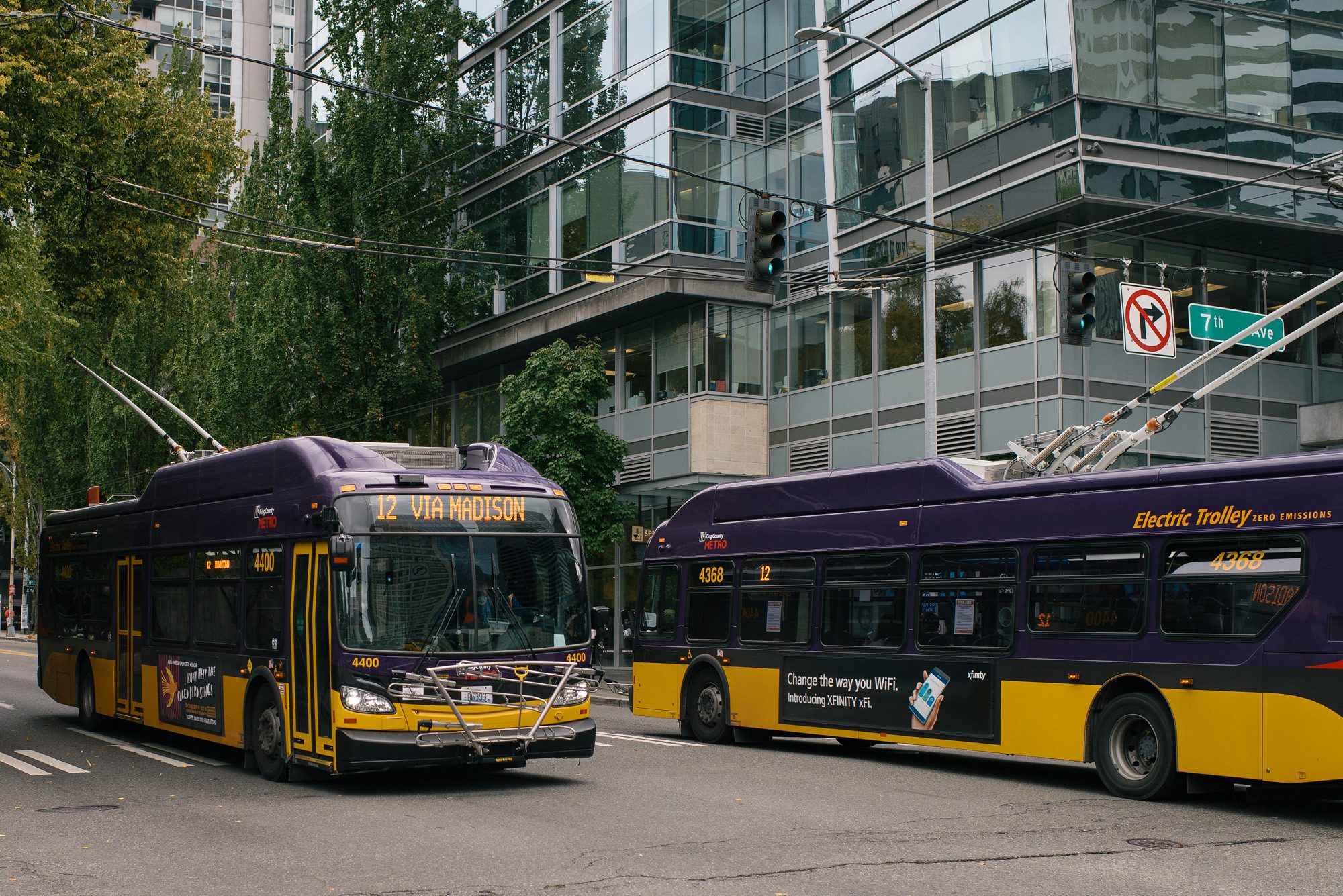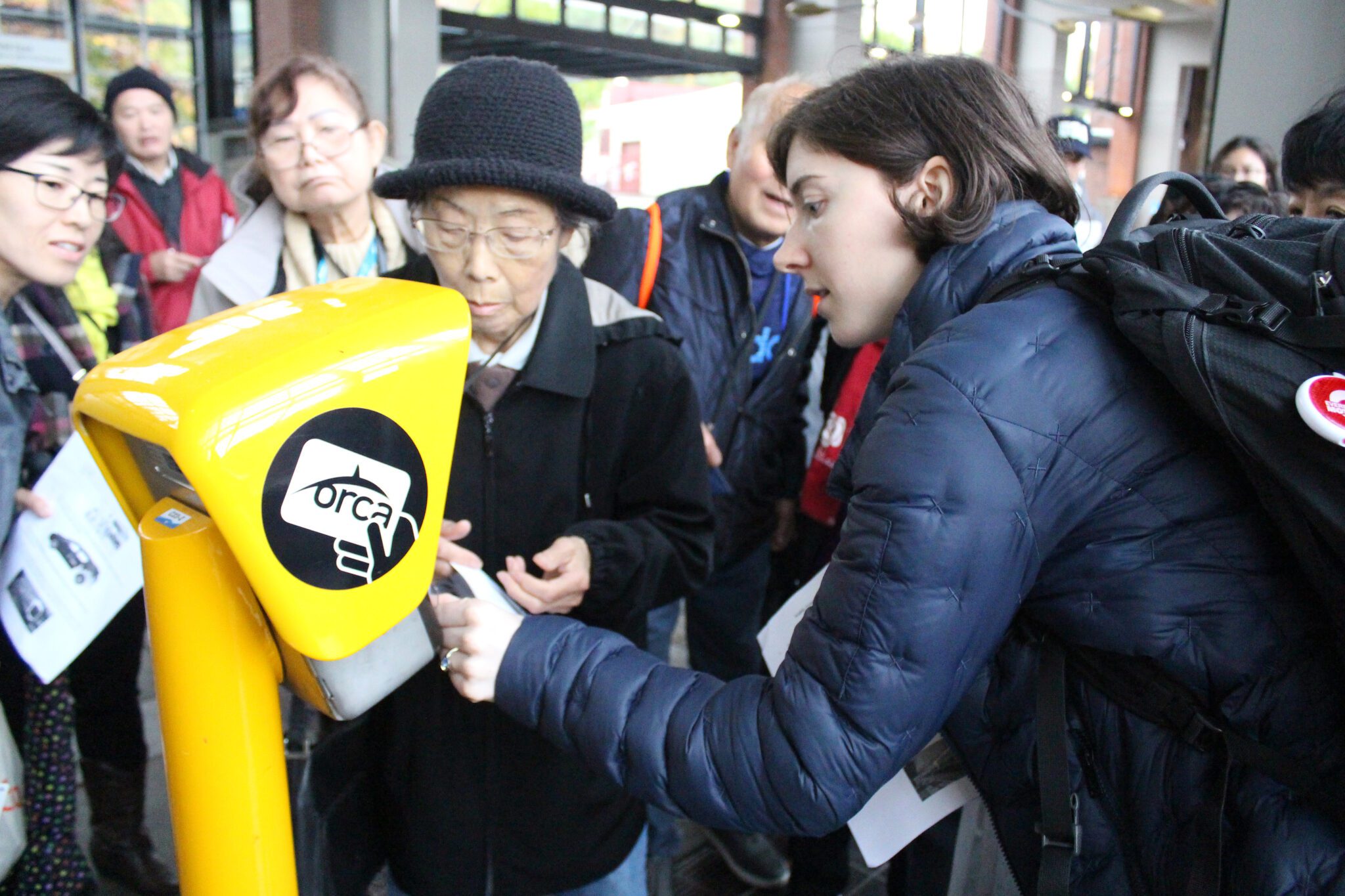 Two King County Metro buses (Route 12) pass each other on Madison St in Seattle, traveling between downtown Seattle and Capitol Hill. Photo: SDOT
Two King County Metro buses (Route 12) pass each other on Madison St in Seattle, traveling between downtown Seattle and Capitol Hill. Photo: SDOT Blog stats: 1,200 words | 6-minute read
At-a-glance:
- We work closely with King County Metro on their twice-per-year service changes which include many bus routes throughout Seattle.
- This fall, Metro is planning changes to service in the Madison Street area in central Seattle.
- We are thrilled to be completing construction on the RapidRide G Line – Madison Street project which will provide new, frequent, reliable RapidRide service to Madison Valley, Central District, Capitol Hill, First Hill, and downtown Seattle!
- Check out this blog post for the latest construction progress details.
- This project is made possible thanks to the Levy to Move Seattle, King County Metro, Sound Transit, the Federal Transit Administration, and the State of Washington.
- The proposed new service will be a significant upgrade for many riders, and there will also be changes to other routes in the area.
- We want to acknowledge that changes to bus routes and arrival times you rely on each day can be challenging. We’ll work closely with Metro to support riders adjusting to these changes as they take effect this fall.
- This blog post highlights what changes you can expect to see and how we prioritized equity and supporting underserved communities with funds from the voter-approved Seattle Transit Measure.
2024 will be a significant year in transit, as we work closely with our partners at King County Metro, including planned service changes to bus routes in Seattle with the launch of the Madison RapidRide G Line. This represents a major service upgrade that will begin this fall, providing brand-new RapidRide-level service through the heart of Seattle.
We are excited about this new robust service opening to riders! We also want to acknowledge that other routes in the area are changing. These proposed changes include tradeoffs and adjustments that can be challenging for some riders. We hope this blog post helps detail what you can expect to see moving forward.
What’s new in the Madison Street area?
Including the new, very frequent service on the RapidRide G Line, Metro will invest an additional nearly 50,000 transit service hours in Capitol Hill. At the same time, the proposed transit service update will include changes to other bus routes in the area. They are intended to better meet community-identified needs, provide service where riders’ needs are greatest, and give riders access to more destinations and connections.
Quick link: To find the proposed changes to routes in the Madison Street area, including charts of updated service frequencies and other key details, please visit King County Metro’s website.
The voter-approved Seattle Transit Measure funds roughly 7 percent of Metro transit service operated in Seattle. Seattle Transit Measure transit service investments fund additional transit trips above what would be provided by Metro without the measure. We are committed to its community-led values and continually reassessing investments based on where mobility needs are greatest.
Proposed Seattle Transit Measure investment in the Madison Street area:
- The majority of Seattle Transit Measure-funded service hours are going toward improving service on Route 60, which serves many communities including Capitol Hill, First Hill, Beacon Hill, Georgetown, and White Center.
- We’re also making additional investments in the evenings and weekends on Routes 11 and 49.
- We are shifting approximately 4,800 hours from the Madison Street area to Route 125, which serves South Seattle College in the Delridge neighborhood of West Seattle.
- Route 125 currently has minimal evening and weekend service. The improved service will help students from across Seattle to better access classes at night and on weekends.
- This area was identified as a top transit service investment equity priority during a recent analysis of Seattle Transit Measure investments system-wide (see details below).

How we determine where Seattle Transit Measure resources are invested with an equity focus
The Seattle Transit Measure benefits transit riders because it adds to the ‘baseline’ level of service provided by King County Metro in the City of Seattle. By funding additional bus trips, the measure provides more frequent bus service on vital routes based on a detailed equity analysis.
Beyond these investments, the measure funds increase access to transit for low-income Seattleites, including youth, elders, workers, and others who may need more support. The measure also enables capital infrastructure improvements to keep buses moving efficiently and addresses other needs as they arise.
In 2021 and 2022, we worked with the Seattle Transit Advisory Board to develop a set of investment criteria for Seattle Transit Measure funds. Equity-focused priorities center on providing additional service on routes in the city that are more likely to be used by historically and currently disadvantaged communities, and targeted at times of the day and days of the week when more equity-priority populations are using transit.
The methodology identifies “gaps” between the City’s Frequent Transit Network and Metro’s proposed bus network and ranks them using an equity-centered score, made up of three parts:
- An Equity Priority Area score, based on the proportion of people living nearby who are BIPOC, low-income, immigrants or refugees, disabled, or who have limited English proficiency
- A time-of-day score, prioritizing times when the highest proportions of reduced-fare riders (ORCA LIFT, Disabled, Senior, and Youth) are using transit
- A service level score, ranking the gap between current bus frequencies and the target frequencies identified in our Frequent Transit Network.
Elevating Equity

Service investments are determined using this prioritization methodology along with additional data such as recent public engagement results and operational considerations. Our 2022 Seattle Transit Measure annual report includes more details, starting on page 16.
Using this robust equity-centered prioritization process directly informed how we identified where to invest Seattle Transit Measure funds in the upcoming service changes in 2024.

Moving forward, we will continue to conduct reviews of previous service investments and coordinate with King County Metro’s planning team regarding shifting investments in 2025 to further align with our core value of Equity. One aspect of this work is balancing shifting investments and working to ensure service continuity on routes with existing Seattle Transit Measure investments. We’ll build upon our strong partnership with Metro’s service planning team to ensure that any reallocated Seattle Transit Measure investments find the right balance.
Next steps
- Please visit King County Metro’s website for the latest details on the Madison Street area transit service proposal.
- Visit our Madison RapidRide G Line project website for the latest construction information, and sign up for email updates to stay informed.
- This summer, we’ll publish a new annual report for the Seattle Transit Measure (STM), with more details on the impacts of the funding on transit service and access programs in Seattle.
- If you have additional questions, you can reach SDOT customer service at (206) 684-ROAD (7623) or email us at 684-ROAD@seattle.gov. Thank you.
Editor’s note – Feb. 26, 2024: We updated this blog post to correct the number of hours planned to be shifted to Route 125.